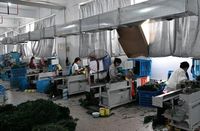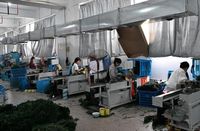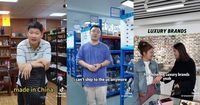US TikTok users are witnessing a notable trend as Chinese content creators promote direct purchases from Chinese factories, seemingly as a response to the Trump administration’s tariffs. These viral videos, showcasing manufacturing facilities linked to popular US brands, suggest that Americans can bypass tariffs by buying directly from China. This movement has sparked discussions about the implications for US-China trade relations and consumer behavior.
A growing number of TikTok videos feature Chinese creators encouraging American consumers to purchase goods directly from Chinese factories. This strategy appears to be a direct challenge to the tariffs imposed by the Trump administration. In one popular video, a creator claims that luxury handbags can be bought for a fraction of their retail price in the US. For instance, TikTok user @LunaSourcingChina showcases a factory producing Lululemon yoga leggings for just $5 to $6, while retail prices in the US exceed $100. The creator asserts that the quality is comparable, raising eyebrows about the authenticity of such claims. Lululemon has responded to these assertions, clarifying that only a small percentage of its products are manufactured in Mainland China. The company emphasizes that genuine Lululemon items are available exclusively through its official channels and partners. Despite the company’s efforts to clarify its supply chain, the videos continue to gain traction, with one clip titled “China exposed the truth” amassing over 8.3 million views.
The recent surge in these videos coincides with escalating trade tensions between the US and China. Analysts suggest that the TikTok algorithm is amplifying this content, potentially undermining US tariff policies. Alex Goldenberg, a senior intelligence analyst at the Network Contagion Research Institute, views this trend as a calculated effort to promote Chinese manufacturing while challenging the effectiveness of tariffs. The legalities surrounding direct-to-consumer purchasing to avoid tariffs remain unclear, particularly with the impending expiration of the small-parcel duty exemption. Currently, Chinese goods face a cumulative tariff rate of 145%. Although the Trump administration has temporarily suspended additional tariffs on select nations, China remains excluded from these measures.
The viral TikTok posts raise significant concerns about the influence of Chinese creators on American consumers. As these videos gain popularity, they highlight the opaque nature of content distribution on the platform, prompting discussions in Washington about the need for a separation between TikTok’s Chinese parent company, ByteDance Ltd., and its global operations. Beyond trade implications, these videos may also have legal ramifications. Some experts believe that disclosing factory information could violate non-disclosure agreements with global brands, potentially jeopardizing supplier relationships. Cameron Johnson, a senior partner at Tidalwave Solutions, interprets this trend as part of a broader shift in global sourcing practices, moving from traditional retail intermediaries to direct factory models. This shift could fundamentally alter how Americans shop and how brands manage their supply chains.
In a video, a Chinese man strolls through a warehouse filled with polybag-wrapped handbags. “This stock is leftover from producing bags for European luxury houses, but thanks to Trump’s tariffs I can’t export to [the] US anymore,” he claims in a post that had over 1 million views, though no longer appears to be available. “Mr. Trump, you think you’ve won. Well, think again. I’ll slash prices and expose the scam. For decades the West called ‘Made in China’ cheap while we quietly crafted their $20,000 ‘Made in Italy’ fantasies. If Chinese quality was trash, would Hermès, Chanel, Gucci beg us to make their bags?” This is “trade war TikTok” and it’s sweeping up luxury’s biggest brands in a tide of bad publicity at a time when the sector’s image is already under fire and demand is down.
Over the last week, posts purporting to come directly from the factory floor of Chinese suppliers to luxury labels have gone viral across the platform. The content creators say they are responding to punitive US tariffs by exposing one of the industry’s biggest open secrets: Many of the world’s costliest luxury goods are in fact made at a fraction of their retail price in China, they claim. Many of the videos are accompanied by links, offering viewers the chance to buy directly from the suppliers. Hermès, Chanel, and Gucci-owner Kering did not respond to requests for comment. LVMH declined to comment. European luxury labels have repeatedly said that they do not manufacture products in China. They say they closely guard their supply chains and are bound by strict laws that dictate when a product can be classified as Made in France or Italy. “I’m doubtful that these [TikTok] claims are legitimate,” said Bernstein analyst Luca Solca. Still, they could pose a reputational risk, he added. Indeed, whether or not these factories have genuine links to high-end labels, the videos have foregrounded a grey market for luxury goods that the industry has been struggling to combat for years.
Manufacturers are unabashedly offering cut-price dupes of some of luxury’s most exclusive items from Hermès Birkins to Chanel Boy Bags. And in doing so, they’re challenging the carefully crafted and tightly controlled image on which the luxury industry trades. “Do not underestimate what this could mean for luxury,” said brand advisor and marketing expert Fabio Becheri in a LinkedIn post. “These videos may seem like noise now. But the narrative they’re pushing could quietly reshape how people perceive value, origin, and authenticity.” Though TikTok trends are often fleeting, this attack on luxury’s image comes at a precarious moment. Some consumers are already asking whether luxury brands are still worth it after punchy price hikes that have far outpaced inflation and reports of diminished quality. A scandal last year that linked labels like Dior and Armani to sweatshops in Milan put fresh cracks in the sector’s pristine facade. A sluggish economy, only worsened by the recent tariff uncertainty and stock market fallout, hasn’t helped matters.
On Monday, sector bellwether LVMH reported that its fashion and leather goods sales fell 5 percent in the first quarter, underperforming expectations and signaling tough times ahead. With consumer confidence dropping, luxury brands are going to have to work harder for wallet share and “trade war TikTok” could make that harder. “[Chinese manufacturers] are blowing up the luxury goods market,” one content creator said in a post with 3 million views. “At this point, if anyone is buying luxury goods anymore I would have to ask, do you need your head examined?”
A viral trend on TikTok, dubbed "Chinese warehouse TikTok," is pulling back the curtain on international manufacturing practices. Many users claiming to be workers in Chinese factories are revealing how little U.S. brands pay to produce their goods — and urging Americans to buy directly from them. The surge in these videos follows President Donald Trump's imposition of steep tariffs on Chinese imports, raising levies to 145 percent in an effort to protect American manufacturers. In response, China has imposed a 125 percent tariff on U.S. goods. The TikTok trend appears to be a strategic digital counteroffensive, giving Chinese producers a platform to reach U.S. consumers directly while sidestepping both tariffs and middlemen.
As the U.S. prepares to close a longstanding tariff exemption on imports under $800 that's set to expire on May 2, 2025, the implications of this social media movement are becoming more pronounced. Experts say many of the TikTok videos are likely produced by counterfeit sellers aiming to exploit the current controversy over tariffs to promote imitation goods under the guise of factory-direct offers. Most videos link directly to Chinese wholesale platforms and include instructions on how Americans can make purchases. Some also feature subtle critiques of U.S. tariff policy and accuse American retailers of excessive markups. The trend has gained momentum as the U.S. prepares to close a longstanding tariff exemption on imports under $800 that's set to expire May 2.
In essence, the TikTok phenomenon highlights a critical intersection of social media influence, global trade dynamics, and consumer behavior. As luxury brands grapple with their image and the realities of their supply chains, the voices from Chinese factories may be reshaping perceptions of value and authenticity in ways that could have lasting effects on the market.






